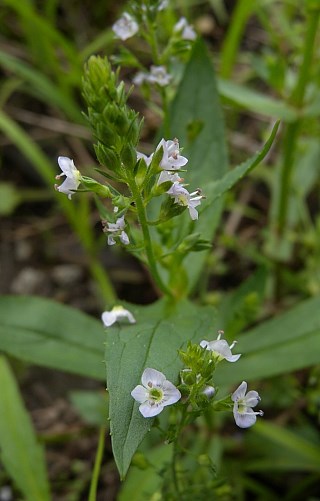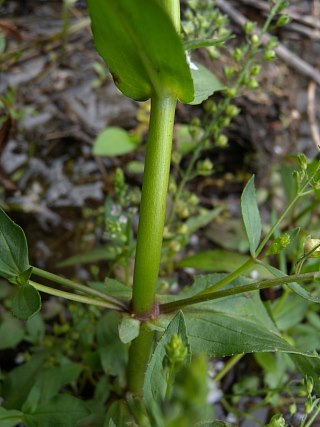Description: This herbaceous perennial wildflower is ½–2½' tall, branching occasionally. The stems are light green, terete, glabrous, and rather stout; sometimes there is a ring of purple where pairs of leaves join the stem. The opposite leaves are up to 4" long and 1½" across; they are lanceolate, elliptic, oblanceolate, or ovate in shape and either smooth or serrated along their margins. The leaf bases are sessile or clasp the stem. The upper surfaces of the leaves are medium green and hairless, while their lower surfaces are pale to medium green and hairless. Both axillary and terminal racemes of flowers are produced; individual racemes have 20-65 flowers and they are 2-6" long.

Individual flowers span about ¼" across, consisting of a
green calyx
with 4 lanceolate teeth, a pale blue or lavender corolla with 4
petaloid lobes, 2 stamens, and a pistil with a single style. Fine dark
blue or purple lines radiate from the center of the corolla, which is
slightly white or yellowish green. The slender ascending pedicels are
about ¼" long. At the base of each pedicel, there is a linear green
bract of the same length or a little shorter. The central stalk of each
raceme, the pedicels, and the calyces of the flowers are either
glabrous or glandular-pubescent. The blooming period occurs from late
spring to late summer and lasts about 2-3 months. On each raceme, only
a few flowers are in bloom at the same time. Each flower is replaced by
a 2-celled seed capsule that is about ¼" long, ovoid, slightly
flattened, and slightly notched at its apex; the outer surface of the
capsule is either glabrous or glandular-pubescent. Each cell of the
capsule contains several tiny seeds, which are distributed to some
extent by either wind or water. After the fertile shoots die down, they
are replaced by sterile shoots during the fall. These sterile shoots
consist of low rosettes of oval leaves that taper to winged petioles.
The root system is fibrous and either rhizomatous or stoloniferous.
This wildflower reproduces vegetatively and sexually.
 Cultivation:
The preference is full to partial sun, wet to consistently moist
conditions, and soil that is muddy or sandy-gravelly. Shallow running
water and occasional submersion from flooding is tolerated. Depending
on stage of development and growing conditions, the size of individual
plants is rather variable.
Cultivation:
The preference is full to partial sun, wet to consistently moist
conditions, and soil that is muddy or sandy-gravelly. Shallow running
water and occasional submersion from flooding is tolerated. Depending
on stage of development and growing conditions, the size of individual
plants is rather variable.
Range & Habitat:
The native Water Speedwell is occasional in NE Illinois, uncommon in
central
Illinois, and rare or absent in the southern section of the state (see Distribution
Map). This species also occurs in Eurasia; some local
populations may consist of introduced Eurasian plants. Habitats consist
of various wetlands, including springs and seeps, muddy borders of
ponds, temporary pools of water, and ditches.
Faunal Associations:
Information is limited. Small bees and flower flies suck nectar from
the flowers. The caterpillars of the butterfly Junonia coenia
(Buckeye) occasionally feed on the foliage. The foliage is not known to
be toxic to either mammalian herbivores or geese.
Photographic Location:
Border of a pool of water at Judge Webber Park in Urbana, Illinois.
Comments:
Because of the small size of its flowers, Water Speedwell is relatively
inconspicuous. This is one of the wetland Veronica spp.,
rather than one of the weedy Veronica spp. that are
found in lawns and along roadsides. Because of the variations of local
populations across its wide distribution, Water Speedwell has an
unstable taxonomic history. Some authorities refer to this species as Veronica
catenata, Veronica comosa, and other
scientific names. Because it is not uncommon to find specimens with
mixed characteristics and there is a lack of consensus among
authorities, these postulated species have been lumped together as
variations of Veronica anagallis-aquatica. Water
Speedwell differs from other wetland Veronica spp.
by the large number of flowers/capsules per raceme (20-65) and its
sessile or clasping leaves. It is much larger in size than the weedy Veronica
spp. that are found on lawns and roadsides; species in this
latter group usually produce individual flowers from the axils of the
leaves, rather than racemes of numerous flowers.